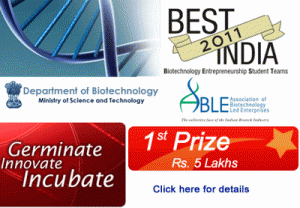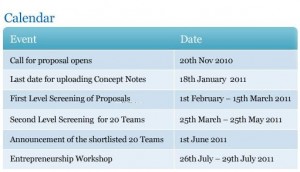BEST (Biotechnology Entrepreneurship Student Team) 2011 INDIA sponsored By DBT
HOW IT WORKS?
A nationwide ‘Call for Proposals’ in the area of life sciences that has commercialization potential will be announced through various communication media.
Students have to form a team comprising of 5 team members, identify a team leader and a faculty member/mentor as a Guide. The Guide is optional.
Each team will submit a Concept Note based on which a Panel will screen the applications and shortlist 20 teams. These 20 teams will attend a fully paid for high quality Entrepreneurship Workshop that will familiarize them on matters related to starting a business venture like Business Plans, IP & Patenting Strategies, Raising Finance, Business Strategies and HR Practices. At the end of the Workshop, each team will develop a business plan based on their Concept and learning from the Workshop and make a ten minute power point presentation to the Jury. The Jury will evaluate and critique each of the business plans and identify 3 winning teams.
The 3 Winning teams will be awarded Prize money of Rs.500, 000/-, Rs. 300,000/- and Rs. 200,000/ respectively.
The winning teams will be also be given an opportunity to attend and present their business plans at ABLE’s Annual BioInvest Conference. BioInvest is ABLE’s flagship conference that brings together on one platform Life Science Companies, Institutional Investors and Investment Bankers to explore opportunities for investment.






 A
A